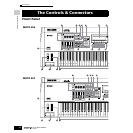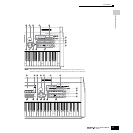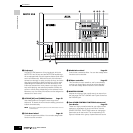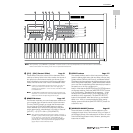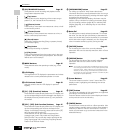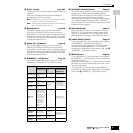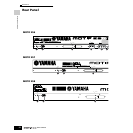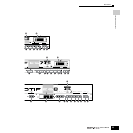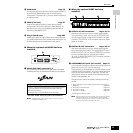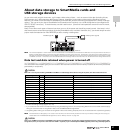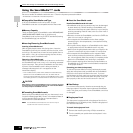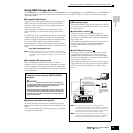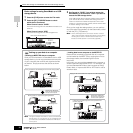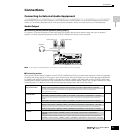
Rear Panel
24
Owner’s Manual
The Controls & Connectors
1 POWER Switch Page 43
Press to turn power ON or OFF.
2 AC INLET (AC Power Cord Socket) Page 26
Be sure to plug the AC power cord into this socket before
plugging the power cord into an AC outlet.
Use only the AC power cord supplied with this instrument.
If the supplied cord is lost or damaged and needs to be
replaced, contact your Yamaha dealer.
The use of an inappropriate replacement can pose a fire
and shock hazard!
3 mLAN expansion board (mLAN16E) or I/O
expansion board (AIEB2) cover Page 25
Either the mLAN expansion board (mLAN16E) or the I/O
expansion board (AIEB2) sold separately can be installed
to this instrument. With the mLAN16E board, you can
conveniently and easily hook up your MOTIF ES to other
mLAN compatible instruments or devices.
The AIEB2 board gives you additional digital I/O options,
featuring both optical and coaxial connectors. Moreover,
the board also includes three stereo ASSIGNABLE
OUTPUT pairs (six analog jacks).
4 USB connectors Page 29
This instrument is equipped with two types of USB
connectors on the rear panel – USB TO HOST and USB
TO DEVICE. The USB TO HOST connector is used to
connect this instrument to the computer via the USB
cable. The USB connection between the instrument and
the computer can only be used for transfer of MIDI data.
No audio data can be transferred via USB. The USB TO
DEVICE connector is used to connect this instrument to a
USB storage device (hard disk drive, CD-ROM drive, MO
drive, flash disk, etc.) via the USB cable. This lets you
save the data created on this instrument to the external
USB storage device and load the data from the external
USB storage device to the instrument. Save/Load
operations can be performed in the File mode.
n For details about USB, see Page 29.
5 MIDI IN/OUT/THRU connectors Page 34
MIDI IN is for receiving control or performance data from
another MIDI device, such as an external sequencer.
MIDI THRU is simply for redirecting any received MIDI
data (via MIDI IN) to connected devices, allowing
convenient chaining of additional MIDI instruments.
MIDI OUT is for transmitting all control, performance and
playback data from the MOTIF to another MIDI device,
such as an external sequencer.
6 BREATH Controller Jack Page 42
Connect an optional Yamaha BC3 Breath Controller here
for expressive breath control capability.
7 FOOT SWITCH jacks Page 42
For connection of optional FC4 or FC5 Footswitches.
When connected to the SUSTAIN jack, the Footswitch
controls sustain. When connected to ASSIGNABLE, it can
control one of various different assignable functions.
8 FOOT CONTROLLER jacks Page 42
For connection of optional foot controllers (FC7, etc.).
Each jack lets you continuously control one of various
different assignable functions – such as volume, tone,
pitch, or other aspects of the sound.
9 ASSIGNABLE OUT L and R jacks Page 31
Line level audio signals are output from this instrument via
these phone jacks (1/4" mono phone plug).
These outputs are independent of the main output (at the
L/MONO and R jacks below), and can be freely assigned
to any of the Drum Voice keys or the Parts. This lets you
route specific Voices or sounds for processing with a
favorite outboard effect unit.
The parts which can be assigned to these jacks are as
follows:
• Drum Voice key to which the drum/percussion
instrument is assigned Page 203
• Any part of a Performance* Page 218
• Any part of a Song* Page 235
• Any part of a Pattern* Page 235
* Including the Audio Input part
) OUTPUT L/MONO and R jacks Page 31
Line level audio signals are output via these phone jacks.
For monophonic output, use just the L/MONO jack.
! PHONES jack Page 31
For connection to a pair of stereo headphones.
@ A/D INPUT jacks Page 33
External audio signals can be input via these phone jacks
(1/4" mono phone plug).
Various devices such as microphone, guitar, bass, CD
player, synthesizer can be connected to these jacks and
their audio input signal can be sounded as the AUDIO IN
part of the Performance, Song, or Pattern.
In the Sampling mode, these jacks are used for capturing
audio data as samples. For stereo signals (such as from
audio equipment), use both jacks. For mono signals
(such as from a microphone or guitar), use only the L jack.
USB
USB is an abbreviation for Universal Serial Bus. It is a serial
interface for connecting a computer with peripheral devices,
and enables much faster data transfer compared to
conventional serial port connections.



